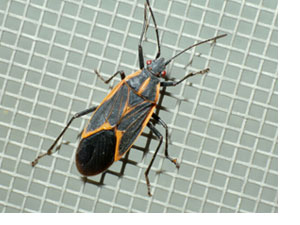 Boxelder bugs may invade buildings, especially during the warm days of autumn, to seek shelter sites for overwintering. They are attracted to lights and will readily fly in open doors and windows. Indoors, these bugs are a nuisance by their presence, produce a foul odor when crushed and may stain curtains with fecal matter. Outdoors, they can be found clustering in large numbers on the sides of trees, buildings and other structures. Large populations are often correlated with long, hot, dry summers. During warm winter and spring days, they may become active, moving from their hiding places into living spaces. Although they do not cause damage to buildings, clothing, food or humans, populations are annoying.
Boxelder bugs may invade buildings, especially during the warm days of autumn, to seek shelter sites for overwintering. They are attracted to lights and will readily fly in open doors and windows. Indoors, these bugs are a nuisance by their presence, produce a foul odor when crushed and may stain curtains with fecal matter. Outdoors, they can be found clustering in large numbers on the sides of trees, buildings and other structures. Large populations are often correlated with long, hot, dry summers. During warm winter and spring days, they may become active, moving from their hiding places into living spaces. Although they do not cause damage to buildings, clothing, food or humans, populations are annoying.
Adult boxelder bugs are flat-backed, elongate, narrow, about 1/2 inch long, 1/3 inch wide and dark brownish-black with three lengthwise red stripes on the pronotum (area behind the head). The head is black with the "beak" or proboscis reddish-orange and the long, thin, four-segmented antennae, half as long as the body. Wings are thick and leathery at the base and membranous at the tip. There are red veins in the wings and the abdomen is bright red under the wings. The nymphs or immatures resemble the adults in shape except they are smaller, more rounded, wingless and bright red. Eggs are dark reddish-brown.
Boxelder bugs do little apparent damage to the boxelder tree. They become a nuisance when they attempt to enter homes to find over-wintering sites. They can stain drapes and sheets with their feces and they can bite. When crushed, the bugs emit a strong disagreeable odor. The most effective control of Boxelder bugs is preventative in nature. The removal of female boxelder trees will usually eliminate the problem. Caulking and sealing entry points into the home will also provide long-term control.